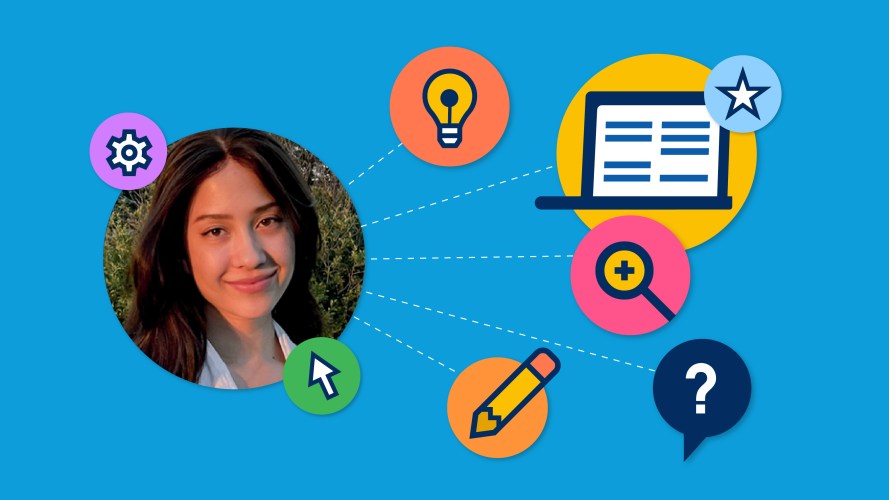Would you trust an intern to help design a prominent piece of your product experience? Salesforce empowered me to do just that. This summer, I was Futureforce’s first intern on the Content Design team. I arrived at the Salesforce Tower full of energy and so many questions: Was I going to be able to actually make an impact? Who was I going to meet? How was I going to make the most of my time here? Would I drown in intern “grunt work”?
But from day one, it was clear that this would be a summer of learning – and real contributions. My team encouraged me to seek out projects that I was interested in and to get involved with them. Even though my internship was structured, I still had the freedom to follow my curiosity. I mainly got to work on Salesforce Starter, designing aspects of Starter’s home page. As a central part of the user experience, this was a great opportunity.
Exploring a breadth of design skills
You may be wondering what content design is. Good content design supports users at the right time with the right language. Imagine baking a cake with no instructions or vague ones. That’d be pretty difficult. The content on a page should guide users to easily accomplish their goals – or complete their jobs to be done.
My team initially gave me projects where I could work on different aspects of the design process. Once I learned more about our product, I proposed redesigning the onboarding experience based on stakeholder feedback. Ultimately, I got the chance to work on a wide range of projects that covered different areas:
- User research and testing: I presented a Figma prototype to users and analyzed how they interacted with it. This validated my research focus and led to unexpected findings that inspired my redesign project.
- Competitive analysis: I assessed other products to determine what their user experience was like and suggested ways to improve our product.
- Designing text and visual content in Figma: Created a variety of content for onboarding walkthroughs, welcome modals, selectable cards, and payment flows.
- Redesigning the onboarding experience: Inspired by the previous research, I explored alternate designs for the onboarding process to help users get started as quickly as possible.
Working on content taught me the value of writing good copy, which is often overlooked. In reality, the words on the screen are responsible for setting the tone of the product. They also affect accessibility for users with a range of needs. Importantly, the words ensure that users get what they need when they need it. And that helps build trust with our customers.
By working on several aspects of the content and UX design for our product, I learned to adapt to changing priorities and shortened deadlines. I also learned how to receive and incorporate design feedback. From product managers to designers and engineers to leadership, I’m grateful to my co-workers who never doubted my abilities to contribute insights and findings.
Building relationships with all kinds of designers
Outside of my team, I was able to meet many talented designers throughout Salesforce. I learned the ins and outs of our design system, observed design critiques, and made valuable connections to people who supported my questions, curiosities, and aspirations.
From these experiences, I discovered how to scale systems and learned more about the technical side of design from our talented engineers. I met designers of varying backgrounds from design systems to Data Cloud to Commerce Cloud.
It was refreshing to be amid such diversity of thought, and I truly value the advice I received. A standout moment was when a colleague encouraged me to be opinionated as a designer and advocate strongly for users. After all, the best user experiences are a result of robust discussions.
What’s it like to be a junior designer at Salesforce?
Read more about the experience of a Futureforce design intern who joined Salesforce after graduation.



More tips for future design interns
To Futureforce design interns – or anyone who’s preparing for an internship – here’s how I made the most of my time at Salesforce:
- If you get to work or visit the Salesforce Tower in San Francisco, get the iced matcha latte on the fifth floor cafe (and make friends with the baristas, who are super friendly).
- Once you’re caffeinated, Slack as many people as you think are interesting (trust me, there are a lot, so you’ll want to do this early on).
- Don’t think about your role too much. Genuinely be curious about anything and everything that’s happening around you. If there’s a cool project that interests you, ask about it! If there’s something you really want to work on, do it (with your manager’s approval, of course).
- Be open-minded. I loved attending different workshops and town halls and talking to PMs, engineers, designers, researchers, technical writers, and people on various teams.
- If you want to get into content or UX design, get started with these helpful learning modules: Writing for Web Accessibility, Designing for Web Accessibility, and User Experience Basics.
Looking back, I am much more equipped with knowledge than I was on my first day. I have a better understanding of how to balance multiple aspects of the design process research, technical constraints, and business objectives while crafting an optimal user experience. I’ve also contributed insights that informed real design decisions for our product. The cherry on top? I met some very bright people along the way. Thank you to my team and the rest of the Ohana for supporting me. Good luck to all of the prospective Futureforce interns – you’re gonna kill it!
































